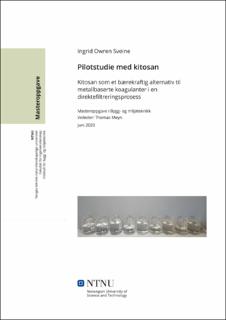| dc.contributor.advisor | Meyn, Thomas | |
| dc.contributor.advisor | Hem, Lars | |
| dc.contributor.advisor | Grefsrud, Ola | |
| dc.contributor.author | Sveine, Ingrid Owren | |
| dc.date.accessioned | 2021-09-20T16:14:42Z | |
| dc.date.available | 2021-09-20T16:14:42Z | |
| dc.date.issued | 2020 | |
| dc.identifier | no.ntnu:inspera:59875849:22174423 | |
| dc.identifier.uri | https://hdl.handle.net/11250/2779409 | |
| dc.description.abstract | FN-sambandet har et eget bærekraftsmål for vannbehandling om å «Sikre bærekraftig vannforvaltning og tilgang til vann og gode sanitærforhold for alle». Med et bærekraftig uttak av drikkevann følger mange ledd i vannbehandlingen, men i denne oppgaven er det valgt å se nærmere på kjemikaliene som brukes i vannbehandling i dag, med spesielt vekt på Skullerud vannbehandlingsanlegg.
På Skullerud vannbehandlingsanlegg benyttes i dag den aluminiumsbaserte koagulanten ALG samt en syntetisk polymer som hjelpeflokkulant i et direktefiltreringsanlegg. Bruken av disse kjemikaliene gir store mengder med næringsfattig slam, noe som er problematisk med tanke på blant annet deponering. Ved å endre koagulant til en mer naturlig variant, kan slammet brukes til for eksempel gjødsling av plen og restaluminium vil heller ikke være et problem i det ferdigrensede vannet.
Kitosan er sett på som et av de mest lovende naturlige alternativene til de tradisjonelle koagulantene. Kitosan er en polymer med koaguleringsegenskaper, og som har vist seg å ha en god evne til å redusere fargetall og TOK, og er derfor vurdert som interessant for Skullerud vannbehandlingsanlegg.
Denne masteroppgaven er utarbeidet for NTNU ved institutt for bygg og miljøteknikk i Trondheim, i samarbeid med Vann- og avløpsetaten. Oppgaven kommer av at Oslo kommune ønsker å bytte ut koagulanten som brukes på Skullerud vannbehandlingsanlegg, som i dag er aluminiumsbasert med en mer bærekraftig koagulant. I denne oppgaven er derfor kitosan prøvd ut som en alternativ koagulant.
Utprøvingen av kitosan ble gjennomført med jar-tester og et pilotanlegg på Skullerud vannbehandlingsanlegg. Målet var å undersøke om kitosan kunne gi tilsvarende kvalitet som anlegget i dag produserer med aluminium. Resultatene fra forsøkene med kitosan var derfor sammenlignet med forsøk gjort på samme pilotanlegg med dagens aluminiumsbaserte koagulant og syntetiske polymer.
Resultatene fra testene antyder at kitosan kan fungere på Skullerud VBA, da det er observert fargefjerning og DOK-fjerning som overholder drikkevannsforskriften. Basert på disse resultatene er det vanskelig å konkludere med noe da det skulle vært gjort flere forsøk både i form av jar-tester, forsøk i pilotanlegg og TOK-analyser. Likevel gir resultatene fra denne oppgaven en god grunn til å undersøke virkningen av kitosan på Skullerud vannbehandlingsanlegg nøyere, samtidig som også andre koagulanter i kombinasjon med kitosan bør undersøkes. En kombinasjon med jern og kitosan er testet ut på blant annet Årnes vannbehandlingsanlegg med gode resultater, og Haugesund vannbehandlingsanlegg har lykkes med å bruke en kombinasjon av kitosan og zirkonium i 15 år. | |
| dc.description.abstract | The UN Association has its own sustainability goal for water treatment: "Ensure sustainable water management and access to water and good sanitation for all". A sustainable extraction of drinking water entails several steps in the water treatment, but the focus of this thesis will be the chemicals used in water treatment today, with special emphasis on Skullerud Water Treatment Plant (WTP).
At Skullerud WTP, the aluminum based coagulant ALG is currently used, as well as a synthetic polymer used as a flocculant in a direct filtration system. The use of these chemicals produces large amounts of nutrient poor sludge, which is problematic in terms of disposal. By changing the coagulant to a more natural variant, the sludge can be used for example as a fertilizer for lawns, while residual aluminum will not be a problem in the purified water.
Chitosan is considered one of the most promising natural alternatives to the traditional coagulants. Chitosan is a polymer with coagulation properties that has shown to have a good ability to reduce color and TOK. Based on this, chitosan is considered interesting for Skullerud WTP.
This master thesis is prepared for the Department of Construction and Environmental engineering at NTNU in Trondheim, in collaboration with the Vann- og avløpsetaten (VAV). The task originated from Oslo Municipality wanting to replace the aluminum-based coagulant used at Skullerud WTP with a more sustainable coagulant. This thesis has tested chitosan as an alternative coagulant.
The testing of chitosan was conducted with jar tests and a pilot plant at Skullerud WTP. The aim was to investigate whether chitosan could provide the same quality as the plant currently produces with aluminum. The results from the chitosan tests were therefore compared to experiments conducted in the same pilot plant using the current aluminum-based coagulant and synthetic polymer.
The results from the tests indicate that kitoflokk can be used as a coagulant on Skullerud WTP, as color removal and DOK removal complying with the drinking water regulations have been observed in this task. Based on these results it is difficult to conclude, as more experiments should have been made both using jar tests, pilot plant experiments and TOK analyses. Nevertheless, the results from this thesis provide a good reason to further investigate the effects of chitosan at Skullerud WTP and testing the effects of other coagulants combined with chitosan. A combination of iron and chitosan has been tested out at Årnes WTP, and Haugesund WTP has succeeded in using a combination of kitoflokk and zirconium for 15 years. | |
| dc.language | | |
| dc.publisher | NTNU | |
| dc.title | Pilotstudie med kitosan: Kitosan som et bærekraftig alternativ til metallbaserte koagulanter i et direktefiltreringsanlegg | |
| dc.type | Master thesis | |
